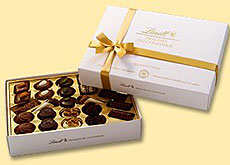
Taste for luxury chocolate keeps Lindt profits sweet

Switzerland's premium chocolate maker, Lindt & Sprüngli, has once again produced sweet financial figures to satisfy its shareholders.
The company, based at Kilchberg near Zurich reported a 2002 net profit of SFr101.9 million ($75.22 million), up 11.4 per cent over the previous year.
The result was achieved against a background of what chairman and CEO Ernst Tanner termed “the most challenging 12 months in recent decades”.
At the annual results conference on Tuesday, Tanner gave swissinfo the recipe for his company’s chocolate success.
“We focus all our attention on what we do best. That is developing, manufacturing and marketing of the best quality chocolate products worldwide.”
“It is a small luxury product but one which everybody can afford at any time,” he added.
Sales in 2002 rose by 5.6 per cent over the 2001 figure to SFr1.681 billion.
The company said the results were all the more encouraging because they were achieved under extremely difficult conditions, characterised by negative consumer mood, ongoing trade concentration and unrestrained competitive pricing.
Volatile
There were also volatile fluctuations in the basic price of cocoa, which rose by over 70 per cent, reaching a 16-year high at the end of September/early October.
The development was partly due to speculation and tight supply on the commodity exchanges, which became even more acute in the wake of the serious unrest in the Ivory Coast, where some 40 per cent of global cocoa production originates.
Lindt & Sprüngli said it had in recent years introduced processes and systems to efficiently minimise the risks in raw material procurement.
It added that public confidence in the company and brand, built up over many years, paid off even in difficult times.
“I think consistency and persistency helped us to gain market shares again last year and will also help us to gain market shares in the future,” Tanner commented.
Consumer needs
“We support our brand with very consumer-oriented advertising. We introduce products that are consumer-relevant and we cover real consumer needs that we have learned from consumer research,” he added.
The company can boast that it introduces about 400 new products or products with different packaging every year.
“It’s an absolute must because we’ve found out that the consumer spends more time in front of a chocolate shelf in a store than in front of other shelves, so that means that he or she is looking for product news,” Tanner told swissinfo.
“We have also established consumer panels in all the big European countries and they clearly show us that [consumers] want something new every season,” he added.
The company said the industry was confronted with even more challenges this year, with an increasingly tough commercial environment.
However, it said it was confident that it could once again achieve its growth target of 5-7 per cent in sales and 8-10 per cent in operating profit.
This would strengthen the balance sheet and enable the firm to repay virtually all its debt in the next two years.
Net debt fell in 2002 from SFr101 million to SFr140 million.
swissinfo, Robert Brookes in Zurich
Lindt & Sprüngli made a profit of SFr101.9 million in 2002, up 11.4 per cent over the previous year.
It posted sales of SFr1.681 billion last year.
The company is confident that, despite adverse market conditions, it can achieve its growth target this year of 5-7 per cent in sales and 8-10 per cent in operating profit.
Lindt & Sprüngli had a worldwide staff of 6,184 in 2002.
In the past ten years, the company has invested more than SFr1 billion in production and acquisitions.
The United States has become the main sales market outside Europe.
The company had 88 boutiques in the US at the end of 2002.
The firm says its goal is to have the Lindt brand available wherever the consumer wants to purchase premium chocolate.
In Switzerland in 2002, total domestic and export sales by the 17 Swiss chocolate producers came to 142,186 tons, valued at SFr1.279 billion.
Average per capital consumption in Switzerland fell back to 11.9 kilos in 2002, 400 grams under the record total of the previous year.
According to industry estimates (2001), around 20 per cent of chocolate bought in Switzerland is purchased by people living in other countries – tourists and cross-border commuters.

In compliance with the JTI standards
More: SWI swissinfo.ch certified by the Journalism Trust Initiative


























You can find an overview of ongoing debates with our journalists here . Please join us!
If you want to start a conversation about a topic raised in this article or want to report factual errors, email us at english@swissinfo.ch.